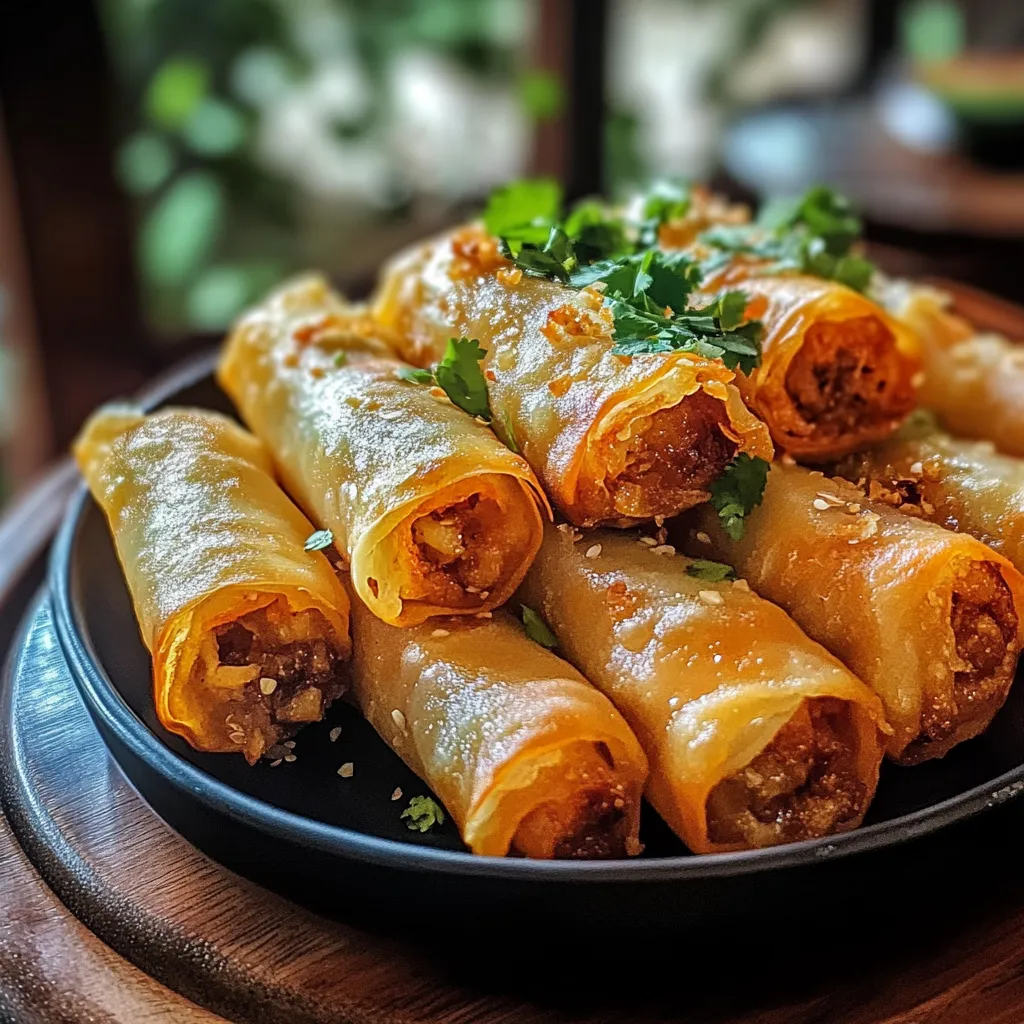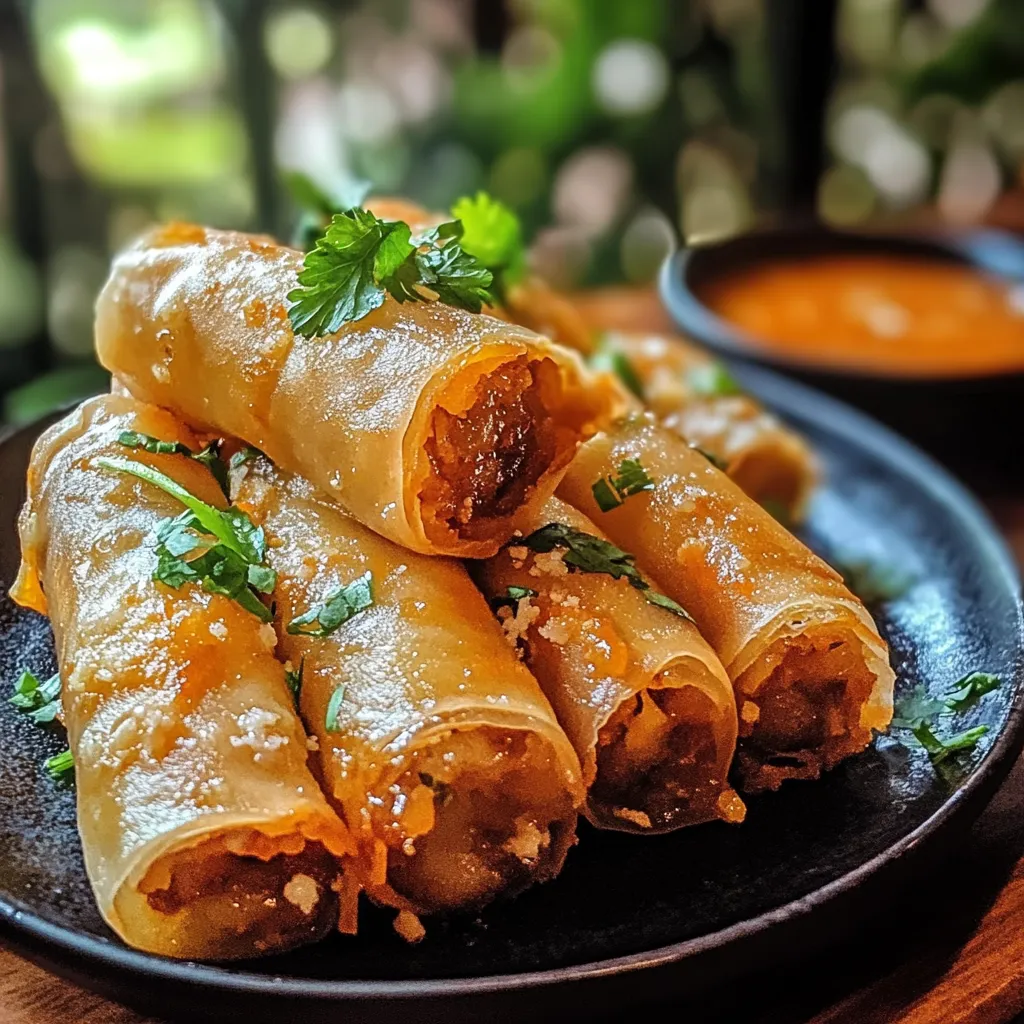 Pin it
Pin it
This hearty Filipino lumpia recipe brings the authentic flavors of the Philippines right to your kitchen. The crispy exterior gives way to a savory filling that balances meat and vegetables in perfect harmony, creating a versatile appetizer or main dish that has become a staple at family gatherings and celebrations in my home.
My journey with lumpia began when my Filipino neighbor shared her family recipe during a neighborhood potluck. After one bite, I was determined to master these crispy rolls and they've since become my signature dish for every gathering.
Ingredients
- Spring roll wrappers: About 20 to 25 sheets for that authentic thin and crispy exterior
- Ground pork: Provides the perfect fatty base for maximum flavor
- Shredded carrots: Add natural sweetness and vibrant color
- Finely chopped green beans: Create texture and earthy notes
- Chopped onions: Form the aromatic foundation of the filling
- Minced garlic cloves: Bring essential pungent depth
- Soy sauce: Introduces umami flavor without overwhelming
- Ground black pepper: Adds subtle heat throughout the filling
- Salt: Enhances all the flavors in perfect balance
- Sesame oil: Contributes an aromatic nuttiness that elevates the filling
- Fresh cilantro: Optional but highly recommended for brightness
- Frying oil: Choose a neutral variety with high smoke point
Step-by-Step Instructions
- Prepare the Filling:
- Combine all filling ingredients in a large bowl. Mix the ground pork, shredded carrots, chopped green beans, onions, garlic, soy sauce, black pepper, salt, sesame oil, and optional cilantro until thoroughly incorporated. The mixture should be well blended with no large chunks of meat remaining. Take your time here as proper mixing ensures even flavor throughout each lumpia.
- Rolling Technique:
- Place a spring roll wrapper on a clean, flat surface with one corner pointing toward you in a diamond orientation. Scoop approximately two tablespoons of filling and place it near the corner closest to you, forming a small log shape. Take the bottom corner and fold it over the filling, tucking it under slightly to create a tight seal around the mixture. Fold the left and right corners inward toward the center, creating an envelope shape that contains the filling. Continue rolling forward with gentle tension until you reach the final corner. Apply a small amount of water to this corner to seal the lumpia completely. Set aside and repeat until all filling is used.
- Frying for Perfection:
- Heat about two inches of neutral oil in a deep, heavy bottomed pan to approximately 350°F. Test the temperature by dropping a small piece of wrapper into the oil. It should bubble immediately and rise to the surface. Working in small batches of 4 to 5 lumpia at a time, carefully slide each roll into the hot oil, avoiding overcrowding which lowers oil temperature. Fry each batch for 4 to 5 minutes, turning occasionally until the exterior is uniformly golden brown and crispy. Listen for the bubbling to quiet down, which indicates the filling is fully cooked. Remove using a slotted spoon or tongs and place on paper towels to drain excess oil.
- Serving Suggestions:
- Present your crispy lumpia hot on a serving platter alongside sweet chili sauce or a traditional Filipino vinegar dip made with white vinegar, garlic, and black pepper. For an authentic experience, serve with a small dish of banana ketchup or sweet and sour sauce. These are best enjoyed immediately while the exterior remains shatteringly crisp.
 Pin it
Pin it
My grandmother always insisted on adding a pinch of sugar to the filling, a secret ingredient that balances the savory elements perfectly. She taught me that lumpia making is as much about patience as technique, and watching her nimble fingers roll dozens at lightning speed remains one of my fondest childhood memories.
Make Ahead Options
Lumpia excels as a make ahead dish perfect for busy households. You can prepare and roll all your lumpia, then arrange them in a single layer with parchment paper between layers in an airtight container. They will keep in the refrigerator for up to 2 days before frying. For longer storage, freeze the uncooked rolls on a baking sheet until solid, then transfer to freezer bags where they will keep for up to 3 months. When ready to cook, fry them directly from frozen, adding an extra minute to the cooking time. This makes lumpia perfect for unexpected guests or quick weeknight meals when time is limited.
Authentic Variations
Regional Filipino variations of lumpia showcase the diversity of this beloved dish. Lumpiang Shanghai features a meat heavy filling with fewer vegetables and is typically thinner and shorter. Lumpiang Sariwa or fresh lumpia uses a soft, crepe like wrapper instead of fried and includes a peanut sauce. Lumpiang Ubod incorporates heart of palm as the star ingredient. In some northern regions, sweet versions filled with banana and jackfruit create a delicious dessert variation. Each family typically has their own special recipe, with ingredients reflecting local availability and personal preference, making lumpia a dish that tells the story of Filipino culinary heritage through countless adaptations.
Serving Traditions
In Filipino culture, lumpia holds a special place at celebratory gatherings called fiestas. These crispy rolls are traditionally arranged on large platters at the center of the table as part of a festive spread. For an authentic presentation, serve lumpia alongside pancit noodles, chicken adobo, and steamed rice. Many Filipino families enjoy these as a midday merienda snack with cold San Miguel beer or sweet fruit juices. For a complete experience, offer various dipping sauces in small individual bowls allowing guests to customize their flavor experience. The communal aspect of sharing lumpia brings people together, reflecting the Filipino value of hospitality and community.
 Pin it
Pin it
Enjoy this crispy and flavorful Filipino lumpia as the highlight of your next gathering—it never fails to impress!
Frequently Asked Questions
- → Can I make lumpia ahead of time?
Yes! You can prepare lumpia up to 24 hours in advance and store them uncooked in the refrigerator (separated by parchment paper to prevent sticking). For longer storage, freeze uncooked lumpia in a single layer, then transfer to a freezer bag once solid. Frozen lumpia can be fried directly without thawing – just add 1-2 minutes to the cooking time.
- → What's the best dipping sauce for lumpia?
Traditional Filipino lumpia is commonly served with sweet chili sauce or a vinegar dipping sauce. For a simple vinegar dip, combine rice vinegar with minced garlic, a pinch of salt, and some black pepper. Other excellent options include banana ketchup, garlic aioli, or a soy sauce-calamansi (Filipino lime) mixture.
- → How do I prevent lumpia from getting soggy?
For crispy lumpia, ensure your oil is hot enough (around 350°F/175°C) before frying. Don't overcrowd the pan, as this lowers the oil temperature. After frying, drain on paper towels to remove excess oil. If serving later, cool completely before storing, then reheat in a 375°F oven for 5-10 minutes to restore crispness.
- → Can I bake lumpia instead of frying?
Yes, you can bake lumpia for a healthier alternative. Preheat your oven to 425°F (220°C), brush the lumpia lightly with oil, and bake on a lined baking sheet for 15-20 minutes, turning halfway through. While baked lumpia won't be quite as crispy as fried, they'll still be delicious with a nice golden exterior.
- → What vegetable substitutions work well in lumpia?
Lumpia is versatile and accommodates many vegetables. Try adding or substituting cabbage, bean sprouts, jicama, water chestnuts, bell peppers, or mushrooms. For a vegetarian version, omit the meat and increase the vegetables, or substitute with crumbled tofu, textured vegetable protein, or chopped mushrooms for a meaty texture.
- → How do I keep the wrappers from tearing when rolling?
To prevent tearing, work with one wrapper at a time and keep the rest covered with a damp cloth. Don't overfill (about 2 tablespoons is ideal), and ensure your filling isn't too wet. Roll firmly but gently, and seal the edges with a little water or beaten egg. If a wrapper tears, you can double-wrap it with another wrapper.
